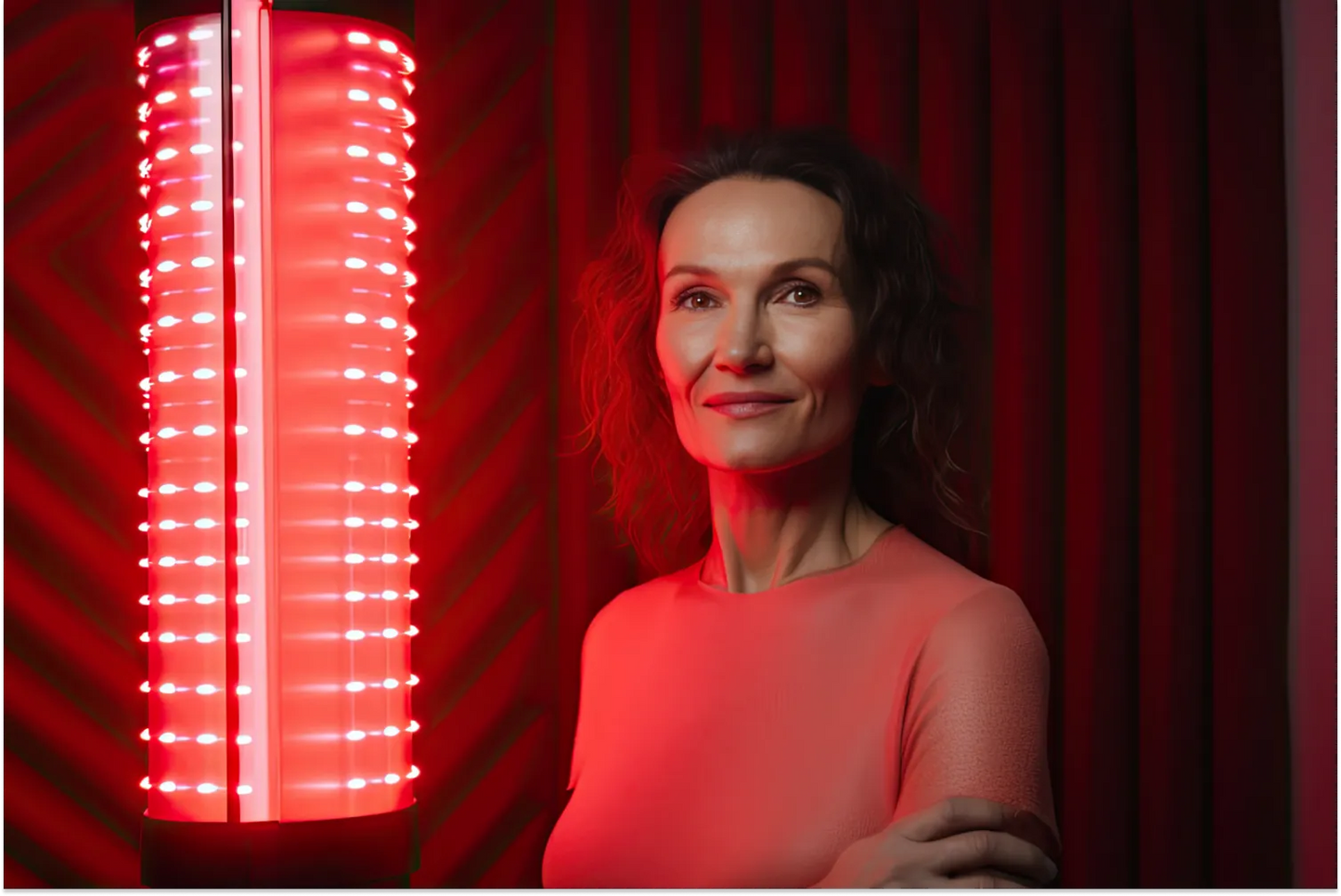
We’ve all faced those moments — standing in front of the mirror, daydreaming of a flawless, smooth silhouette when our eyes start to fixate on the dimpled, puckered areas on our thighs or buttocks. Another daydream ruined by an old nemesis: cellulite.
When it comes to cellulite, one promising solution that’s been gaining traction is red light therapy.
A shining light in the vast landscape of beauty and wellness, this therapy offers a glimmer of hope for many. But the burning question remains: Can it truly unlock the secret to diminishing the appearance of cellulite?
What Is Cellulite and What Causes It?
The term “cellulite” might sound sophisticated, but its reality is far less appealing.
Envision fat deposits residing just beneath the skin. These fat cells push against the connective tissues, causing the skin above to form that familiar puckered appearance of cellulite. And while cellulite is as natural as the freckles on your nose, it’s also a common beauty concern.
The key to understanding cellulite (and attempting to address it effectively) will require a deeper dive into its root causes.
Genetics
Your family tree might hold more secrets than the identity of your ancestors. Deep within your DNA lie the blueprints for numerous distinct traits — from your dad’s razor-sharp wit to your mom’s radiant smile.
Your specific genetic code can also hide predispositions, such as how likely you are to develop cellulite. So, if your grandmother or aunt often lamented about that distinct dimpling on their skin, it might foreshadow your own cellulite journey.
Gender
Nature, in its infinite wisdom, has created female bodies with a unique configuration of fat, muscle, and connective tissue. This unique design, while beautiful, predisposes women to cellulite more than their male counterparts.
While men aren’t entirely spared, it’s the ladies who bear the brunt more often. It’s estimated that as many as 10 percent of men have cellulite. On the other hand, roughly 85 to 90 percent of all women who have gone through puberty will experience it.
Age
As we age, we’ll experience a wide variety of new experiences and challenges. The skin, our outermost protective shield, also evolves as we get older.
Over time, the skin starts to lose its youthful springiness as collagen and elastin production slows down. This decline in elasticity, an unavoidable aspect of aging, can start to make the uneven contours of cellulite rise to the forefront.
Diet
Everyone knows the old saying, “You are what you eat.” As you can imagine, eating a diet that’s punctuated with fatty delights, salty snacks, carb-loaded treats, or an excess of sugar indulgences can be a precursor to more visible cellulite.
It’s important to remember that what we put on our plates not only fuels us but also shapes our external appearance.
Physical Activity
In the age of digital domination, many of us lead lifestyles tethered to screens, leading to hours of sitting. Whether it’s the ergonomic chair at the office or the plush couch at home, prolonged inactivity is a modern-day reality.
Frequent periods without movement can further exacerbate the cellulite situation, making those dimples even more pronounced.
Hormones
Our bodies’ hormonal cycles can often resemble a roller coaster, and these fluctuations can play a critical role in the appearance of cellulite.
Estrogen, the primary sex hormone for women, encourages the body to store more fat. This means that having elevated levels can encourage cellulite in areas where your body prefers to store fat. For example, events like pregnancy introduce a whirlwind of hormonal changes, which can influence the skin’s texture.
Weight Gain
Gaining weight, especially rapidly, as is the case during pregnancy, can be like adding fuel to the cellulite fire. The increase in fat cells can exert pressure on the connective tissues, pushing them to the surface. This results in the distinct puckering we associate with cellulite.
Smoking
While the health perils of smoking are broadcasted pretty widely, its implications for the skin are discussed less often. See, smoking doesn’t just harm the lungs; it also wreaks havoc on the skin’s foundation, diminishing its strength, elasticity, and glow. This, in turn, can accentuate the cellulite landscape.
Stress
Modern life, with its dizzying pace and endless demands, is often a recipe for stress. Unfortunately, the body’s response to these stressors is to increase cortisol levels.
Cortisol is the primary stress hormone in the body and can be a key player in fat accumulation, especially in areas like thighs and buttocks, making cellulite more visible.
Clothing
Your wardrobe choices, particularly the snugness of your undergarments, can have unexpected ramifications on cellulite.
That skin-tight pair of jeans or constricting underwear can restrict blood circulation. Reduced blood flow can accentuate the appearance of cellulite, which is why it’s important to be mindful of what we wear.
What Is Red Light Therapy?
Imagine harnessing the power of specific light waves to pamper and rejuvenate your skin. It may sound like something from a sci-fi movie, but that’s precisely what red light therapy can do!
Sometimes known as low-level laser therapy, this groundbreaking technique utilizes low-energy light waves not just to invigorate your skin but also to refresh other body tissues. It’s an ingenious blending of science and nature.
There’s no denying that red light therapy has been making waves in the wellness world, offering a holistic and natural approach to skin care. Here are a few of the ways it can help address cellulite.
Collagen Production
Collagen is to our skin what a foundation is to a building, as it provides structure, support, and elasticity. When the red light caresses the skin, it can stimulate collagen production. The outcome? Skin that feels more taut and firm, naturally reducing the appearance of those pesky dimples.
Circulation
A good circulation system is like a well-functioning highway, ensuring smooth transit. When blood flows efficiently, it can help dispel stored fats and toxins that might be contributing to cellulite. Red light therapy encourages this flow, paving the way for skin that looks smoother and feels revitalized.
Fat Reduction
We all have those stubborn fat cells that seem to love us a bit too much. Some intriguing studies suggest that red light therapy might just be the nudge that helps them on their way out. While it’s far from being a magic wand for weight loss, red light therapy can certainly be a supportive ally on the journey.
Cellular Function
At the heart of our being are millions of cells, each with its own job. Red light therapy has a way of energizing these microscopic units, aiding tissue repair and enhancing overall skin vitality.
Skin Repair
Our skin is quite the warrior, facing the brunt of external aggressors daily. Red light therapy lends a helping hand, supporting the skin’s natural recovery processes. It fosters an environment where skin can regain its luster and vibrancy, which can go a long way toward minimizing cellulite.
How To Use Red Light Therapy for Cellulite Reduction
Taking a leap into the world of red light therapy is like embarking on a spa journey for your skin.
Many dermatology clinics and wellness centers now offer this luxurious experience. Each session resembles a short, rejuvenating nap, typically lasting about 15 to 20 minutes. For optimal results, it’s generally best to bask in this red glow a couple of times a week.
And, just like how we relish in our favorite rituals (like savoring a glass of wine at day’s end), red light therapy sessions can be your personal self-care indulgence. After all, we deserve moments that make us feel good, inside and out.
What Are the Potential Side Effects of Red Light Therapy?
Red light therapy is widely celebrated for its holistic and rejuvenating effects on the skin and body. However, just as every rose has its thorn, red light therapy can also have a few side effects for some individuals.
Here are some potential side effects of red light therapy:
- Eye strain: Our eyes are delicate structures and are sensitive to intense light sources. Direct exposure to the powerful beams of red light therapy can lead to discomfort or strain.
- Skin irritation: While many embrace red light therapy for its skin-enhancing benefits, a small fraction might notice some redness or even a rash post-session.
- Headaches: A rare but possible side effect, some individuals might experience a mild headache post-treatment.
- Insomnia: Overexposure to red light therapy might throw our body’s internal clock off balance, leading to sleep disruptions.
- Nausea: Though occurring rarely, a few individuals might feel a wave of nausea post-session.
How Can You Support the Benefits of Red Light Therapy?
There is no denying that red light therapy can be a powerful tool for addressing cellulite. However, you shouldn’t think of it as a singular solution. Instead, it’s most effective when used as part of a holistic approach.
Here are a few other ways that you can address cellulite from the inside out.
Balanced Diet
Your body is a temple, and what you feed it reflects on the outside. Opting for nutrient-rich foods brimming with antioxidants, vitamins, and minerals can support your overall health, giving your skin the fuel it needs to shine even brighter alongside red light therapy.
Regular Exercise
The benefits of staying active stretch far beyond muscle tone. Regular exercise promotes strong blood circulation, which helps disperse stored fats and toxins. This enhanced blood flow complements red light therapy’s skin-smoothing effects, ensuring that you’re burning fat both inside and out.
Stay Hydrated
Everyone knows that water is the essence of life. Quenching your skin’s thirst from and keeping it hydrated can further amplify the benefits of red light therapy. And here’s a pro tip: sipping on Dr. Kellyann’s Bone Broth can not only hydrate but also nourish your skin cells so that you look as good as you feel.
Collagen Supplements
Dr. Kellyann’s Collagen Peptides are a delicious and easy way to incorporate more collagen into your diet. These peptides can support the skin’s natural collagen, adding another layer of support for your skin.
Massages
Just as a gentle breeze can ripple through a still pond, massages can stimulate the deeper layers of your skin and help relieve tension. As a result, the area can experience enhanced circulation that can help break down stubborn fat cells, making red light therapy even more effective.
Topical Creams
While red light therapy dives deep into the skin, topical creams work on the surface. Some of these lotions, creams, and potions, especially those infused with caffeine or botanical extracts, can help tighten and tone the skin, acting as the perfect outer layer complement to red light therapy’s deeper work.
Reduce Stress
You probably know that our mental state can manifest physically in a few different ways. As we mentioned earlier, chronic stress can lead to hormone imbalances, which can dramatically affect our skin’s health. Meditation, deep breathing exercises, or even a simple walk in the park can harmonize your mind, preparing your body to respond even better to red light therapy.
Limit Smoking and Alcohol
While we all enjoy letting our hair down occasionally, both smoking and excessive alcohol can dehydrate and prematurely age the skin. Reducing your consumption of these substances can help your skin be more receptive to the benefits of red light therapy.
The Bottom Line
Red light therapy offers a glimmer of hope for those of us yearning for smoother, more radiant skin.
However, the true magic unfolds when red light therapy is just one part of a holistic ensemble. Just like a well-cooked meal is more than just its ingredients, the combination of red light therapy with a balanced lifestyle can be transformative.
And if you’re looking for that extra touch of nature’s magic, consider partnering with Dr. Kellyann. With a library of recipes, wellness tips, and supportive supplements, we’re here to help you on every step of your wellness journey.
Sources:
Cellulite – Symptoms and Causes | Mayo Clinic
Cellulite: Current Understanding and Treatment | PMC
How Are Traits Passed On Through DNA? | Scientific American
Comparison of Cellulite Severity Scales and Imaging Methods | PMC
Red Light Therapy: Benefits, Side Effects & Uses | Cleveland Clinic
Chronic Stress Puts Your Health at Risk | Mayo Clinic
A Controlled Trial to Determine the Efficacy of Red and Near-Infrared Light Treatment in Patient Satisfaction, Reduction of Fine Lines, Wrinkles, Skin Roughness, and Intradermal Collagen Density Increase | NCBI Bookshelf





